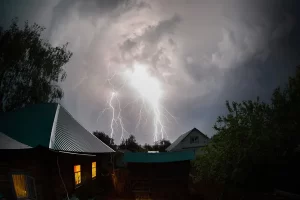Unsure what makes up roofing besides shingles? Use our numbered roofing diagram to understand the specific aspects of roofing and its layers to confidently communicate with your roof specialist during your following roofing venture.
Do you Know the Frequent Aspects of Roofing?
Roof Ridge: The roof ridge or ridge of roofing is the horizontal line running the roof’s duration in which the two roofing planes meet. This intersection produces the greatest point on the roofing, sometimes known as the top. Hip and ridge shingles are specially intended for this element of roofing.
Ridge vent: A ridge vent is an exhaust vent that runs horizontally along the top from the roofing allowing warm, moist airflow to escape through the attic room. Use our ventilation calculator to compute your attic room ventilation specifications and figure out how much exhaust ventilation you should adequately ventilate your roof and attic room.
Flashing: Flashing is a metal material put in at joints openings, all-around chimneys, and then any dormer windows or skylights to aid and prevent water intrusion. You could recognize flashing as metal stair steps alongside a chimney or sidewalls on the roofing.
Hip: The hip on the roofing is the intersection of two roofing aircraft that meet up to form a sloping ridge jogging through the maximum on the eave. Hip and ridge shingles are specially intended for this element of roofing.
Roof Deck: The roof deck is the roofing system’s structural groundwork base, generally made of wood or plywood.
Roofing Underlayment: Roofing underlayment is a layer of material, generally synthetic or felt, that brings added defense on the top of the roof deck and under the shingles. Synthetic underlayment will help get rid of moisture content and supply defense against water infiltration. Synthetic underlayment is now a favorite material selection over felt due to verified water-resistance overall performance and long-lasting toughness.
Roof Valley: The roof valley is the V-shaped intersection between two sloping rooftops joining with a position to provide water runoff.
Laminated Architectural Shingles: Laminated architectural asphalt shingles consist of several layers of tabs to incorporate dimension, overall performance, and sturdiness into roofing. Architectural shingles are sometimes known as three-dimensional shingles or laminated shingles. The contrary of architectural shingles is three-tab shingles, which can be made as one layer of tabs and appear flat or minus the laminated shingle’s dimension.
Roof Gable: A roofing gable is the triangular area of the outer wall structure in the top from the roofing between sloping roofing and eave. A roofing gable might be termed as a rake.
Metal drip edge: A metal drip edge is a thin strip of noncorrosive metal applied in the rake and eave to aid leaking water by facilitating water runoff to guard the wall structure’s underlying area.
Dormer: A dormer is a raised area of the roofing. Dormers commonly consist of a window that projects vertically from the slope in the roofing.
Ice and water barrier: An ice and water barrier is a self-adhered waterproofing material put in along eaves, valleys, sidewalls, and other hypersensitive locations to guard against ice damage and wind-driven rainwater.
Eave: An eave is the lower boundary from the roofing that overhangs the wall structure generally found in the initial three-foot roofing.
Under eave vent: Undereave vents are intake vents positioned under the roofing eaves, bringing cool, dry air into the attic room. Once more, you can use our ventilation calculator to compute your attic room ventilation specifications and figure out how much ingestion ventilation you should properly ventilate your roof and attic room.
Seeing that you’re knowledgeable about roofing’s essential body structure, you will commence discovering dormers and gables everywhere you turn. More significantly, you will be equipped to have a knowledgeable discussion with the roof specialist as soon as the time arrives to get whole new roofing.
For more information on roofing layers and parts that define a whole roofing system, go to our website or request our professionals for more information. Need a roof specialist? Contact us for more information and avail our services now!







